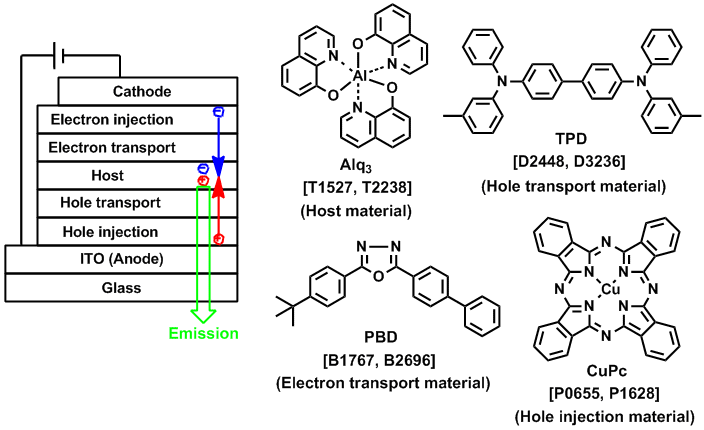Published TCIMAIL newest issue No.197 | New tool "TCI SpectraViewer" | [TCIPracticalExample] The Synthesis of Rubicene... | Product Document Searching Made Easy by 2D Code!
TCI uses cookies to personalize and improve your user experience. By continuing on our website, you accept the use of cookies. You can change or update your cookiesettings at any time.
Maximum quantity allowed is 999
Please select the quantity
Organic Light-Emitting Diode (OLED) Materials
Organic light-emitting diode (OLED) devices have received much attention, because they are expected to be a next generation display and light source, thanks to lightweight and flexible organic materials. The OLED was focused on practical use, after Tang et al. first observed the OLED device by use of a two layered organic thin film.1) Adachi et al. further reported a three layered device, in which a host layer is sandwiched by hole transport and electron transport layers. In addition, they reported a two layered system, in which one layer has roles of host and electron transport properties.2,3) A five layered system including electron injection and hole injection layers has been also studied in order to improve the efficiency of carrier injection. One can control RGB colors of emission by selection of a dopant into a host layer. A suitable combination of the dopant can give a white colored device.4,5) An application using the white organic light-emitting device (WOLED) is an OLED light panel.6) An amorphous material is useful for an OLED device, because it is transparent, homogeneous, isotropic and easily processible. A practical OLED device further requires excellent heat-resistance and durability. Many hole transport materials based on triphenylamine derivatives (TPD) are widely usable, because they are heat-resistant and amorphous.7,8) In addition to the TPDs, oxadiazole derivatives (PBD) having an electron transport property,9) Alq3 as a host material,1) and blue emissive distylyl derivatives10) are fundamental materials for amorphous OLED devices.


A conventional fluorescent material provides only 25% of a singlet exciton but loses 75% of the triplet one by a nonradiative deactivation, although it has a high current density. On the other hand, a phosphorescent material may provide 100% EL quantum efficiency through an intersystem crossing from singlet to triplet excited states. The phosphorescent Ir(ppy)3 and its analogues have been reported so far.11) Recently, metal-free materials exhibiting thermally activated delayed fluorescence (TADF) were investigated as well. Adachi et al. reported more than 25% quantum efficiency by use of fluorescent materials having a low energy gap between singlet and triplet excited states, because an inverted energy transfer occurs from the triplet to the singlet state.12,13)
References
- 1)C. W. Tang, S. A. VanSlyke, Appl. Phys. Lett. 1987, 51, 913.

- 2)C. Adachi, S. Tokito, T. Tsutsui, S. Saito, Jpn. J. Appl. Phys. 1988, 27, L269.

- 3)C. Adachi, S. Tokito, T. Tsutsui, S. Saito, Jpn. J. Appl. Phys. 1988, 27, L713.

- 4)Review: B. Luessem, M. Riede, K. Leo, Phys. Org. Semicon. (2nd Edition) 2012, 427.
- 5)Review: C. Adachi, T. Oyamada, T. Matsushima, Mol. Electron. Bioelectron. 2007, 18, 25.
- 6)Review: H. Sasabe, J. Kido, J. Mater. Chem. C 2013, 1, 1699.

- 7)Y. Shirota, K. Okumoto, H. Inada, Synth. Met. 2000, 111-112, 387.

- 8)X. Zhou, J. Blochwitz, M. Pfeiffer, A. Nollau, T. Fritz, K. Leo, Adv. Funct. Mater. 2001, 11, 310.

- 9)M. Era, C. Adachi, T. Tsutsui, S. Saito, Chem. Phys. Lett. 1991, 178, 488.

- 10)C. Hosokawa, H. Higashi, H. Nakamura, T. Kusumoto, Appl, Phys. Lett. 1995, 67, 3853.

- 11)C. Adachi, M. A. Baldo, S. R. Forrest, M. E. Thompson, Appl. Phys. Lett. 2000, 77, 904.

- 12)H. Uoyama, K. Goushi, K. Shizu, H. Nomura, C. Adachi, Nature 2012, 492, 234.

- 13)Q. Zhang, B. Li, S. Huang, H. Nomura, H. Tanaka, C. Adachi, Nat. Photonics 2014, 8, 326.

Explore Organic Light-Emitting Diode (OLED) Materials Categories
- Home
- Products
- Materials Science
- Electronic Materials
- Organic Light-Emitting Diode (OLED) Materials

